Except for chest day, is there any day higher than arm day? Sure, it’s great to bench press, but little can compare to a pleasant arm pump. The bicep muscles are arguably a very powerful muscle group for aesthetics, as nothing beats pumped-up bicep muscles bulging out of your tee shirt. The most effective ways to achieve size and strength within the biceps is with barbell exercises. Science has shown that free weights are simpler than machines for muscle growth, so barbells are essential, whatever the muscle group or workout routine. In this text, we’ll teach you the five best biceps exercises using a barbell, that are all bicep curl variations.
Table of Contents
- 5 Best Bicep Barbell Exercises
- Other Bicep Exercises
- Anatomy of the Biceps
- Programming Suggestions
5 Best Bicep Barbell Exercises
On this section, we’ll explain the most effective biceps exercises to take your bicep workout to the subsequent level and help those arm muscles grow to a different level. For all the exercises, you should use an everyday barbell and add weight or a fixed-weight barbell.
1. Standing Barbell Curl
Just because the squat is the king of leg exercises and bench press is the king of chest exercises, the barbell biceps curl is the king of biceps exercises. The barbell bicep curl is a variation of the classic dumbbell curl, primarily targeting the biceps brachii. It also involves the brachialis, brachioradialis, and various forearm muscles. The forearm muscles include the flexor and extensor muscles to assist stabilize the wrist and maintain a robust grip.
Instructions:
- Stand tall along with your feet shoulder-width apart.
- Grab the barbell with an underhand (palms facing out) grip, hands barely wider than shoulder-width apart. Keep your arms straightened so the barbell hangs near your thighs.
- To assist keep the body stable, keep your elbows near your body, shoulder blades pulled back, and core engaged.
- Exhale your breath and slowly curl the barbell upward towards your chest by flexing the elbow. Keep your entire body and upper arms regular, moving only your forearms.
- Squeeze the biceps as much as possible at the highest of the lift to feel the contraction. You should definitely maintain control of the burden without using your body for momentum, like by swaying the back.
- Inhale while slowly lowering the barbell back all the way down to the starting position. Give attention to the stretch of this negative portion of the lift as well. Make sure you fully extend your arms to get the utmost range of motion.
- Repeat for reps anywhere within the five to 12 range.
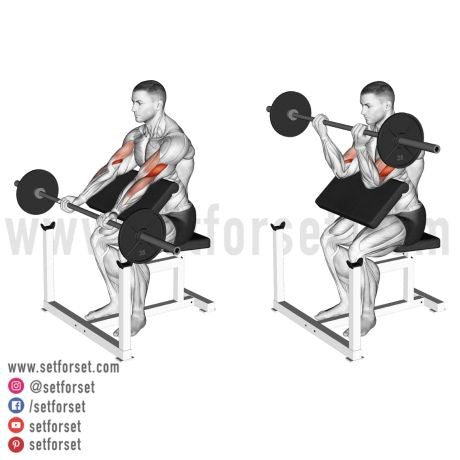
2. Barbell Preacher Curl
One other excellent barbell biceps exercise is the barbell preacher curl. The barbell preacher curl primarily targets the biceps brachii, with secondary work to the brachialis, brachioradialis, and forearm muscles. The exercise requires a preacher bench, or you’ll be able to create one using an incline bench.
Instructions:
- Adjust the preacher bench so your body suits, so your chest is pushed against the highest of the pad, and your triceps are firmly placed on the angled pad.
- While sitting (or kneeling), grab the barbell with an underhand or supinated grip and hands barely wider than shoulder-width apart. Your arms ought to be fully prolonged.
- Exhale and slowly curl the burden toward your brow by flexing your elbows. Give attention to squeezing the muscle at the highest of the contraction. Keep your upper arms still, and only use your forearms throughout the lift.
- Keep your shoulders pulled back, core tight, and elbows planted against the pad throughout the motion.
- Inhale and slowly lower the burden so far as possible without locking out our elbows. Give attention to feeling the negative portion when you lower the barbell.
- Repeat for desired reps.

3. Barbell Drag Curl
The barbell drag curl is a lesser-known movement than the usual or preacher curl, but it surely is just as effective at constructing biceps muscle. The barbell drag curl is a variation of the straight barbell curl, where the barbell is dragged along the torso relatively than being curled upward in a linear motion like a traditional barbell curl. Although it’s a shorter range of motion, it removes momentum from other muscles just like the shoulders to put more time under tension on the biceps. It also primarily targets the biceps brachii, with secondary work to the brachialis, brachioradialis, and forearm muscles.
Instructions:
- Stand tall along with your feet shoulder-width apart.
-
Grab the barbell with a supinated grip, along with your hands against your upper thighs, barely closer than an everyday curl. Keep your arms straightened so the barbell hangs near your thighs.
- You may as well use an overhand grip, but underhand is the usual and more comfortable.
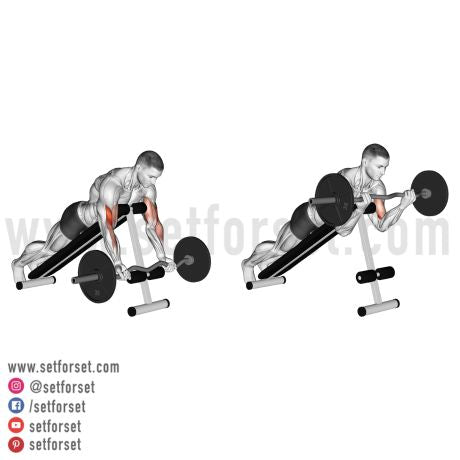
4. Barbell Spider Curl:
One other great barbell biceps exercise is the barbell spider curl, a novel variation with a preacher-like movement. Like all the opposite curl variations, spider curls primarily work the biceps, with accessory work to the brachialis, brachioradialis, and forearm muscles. The angle of the body allows for a greater range of motion and creates shoulder flexion. Exercises like this with shoulder flexion put more emphasis on the short head of the biceps. The shoulder flexion puts the long head in a disadvantageous position, so the short head takes the majority of the lift.
Instructions:
- Arrange an incline bench to either 30 or 45 degrees.
- Stand so that you just are facing the inclined bench, with one foot on either side of the seat on the bench. Lean forward in order that your chest is against the inclined padded bench.
- Have someone hand you the barbell, or take your set-up position holding the barbell with an underhand grip, hands barely outside your shoulders. Your arms ought to be fully prolonged straight down in order that the barbell is below your shoulders, but keep a slight bend within the elbows to avoid locking them out.
- Keep your chest against the bench pad in any respect times and your feet flat on the ground. Exhale and slowly curl the bar upwards towards your shoulders by flexing the elbow. Be sure that you retain your elbows and triceps against the pad throughout.
- Squeeze the biceps at the highest of the curl to get the utmost muscle contraction.
- Inhale and slowly lower the barbell back all the way down to the starting position, but avoid locking out your elbows. Give attention to the biceps time under tension as you slowly lower the bar.
- Repeat for reps.
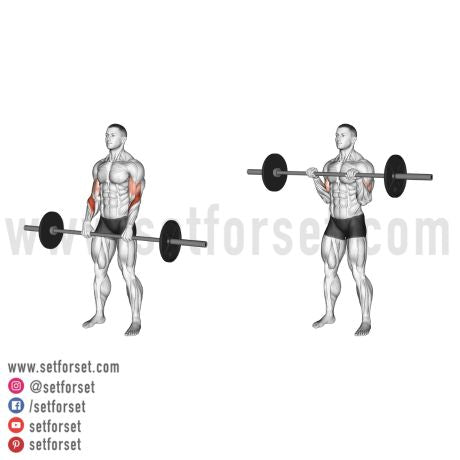
5. Reverse Barbell Curl:
The reverse barbell curl is a bicep curl variation where you utilize a reverse grip in order that your palms are facing the bottom while performing barbell curls. The barbell reverse curl primarily targets the brachioradialis, which is technically not a part of the biceps muscles but is significant for constructing biceps strength. It also works the biceps, the brachialis, and other forearm muscles secondarily. This exercise ought to be done towards the tip of the biceps workout, after the straight barbell curl and other bicep exercises, because it primarily focuses on the forearms. In case your forearms and brachioradialis are pre-exhausted, your biceps training will suffer because they may give out, regardless that you’ve gotten the biceps strength.
Instructions:
- Stand tall along with your feet shoulder-width apart.
- Grab the barbell with an underhand grip, along with your hands in keeping with your feet and shoulders. Keep your arms straightened so the barbell hangs near your thighs.
- Keep your elbows tight next to your body, shoulder back, and core engaged.
- Exhale and curl the barbell upward towards your shoulders by flexing the elbow. Give attention to squeezing the brachioradialis to lift the burden.
- Similar to a traditional biceps curl, maintain control of the burden without using your body.
- Inhale and slowly lower the barbell back all the way down to the starting position. Fully extend your elbows without locking them.
- Repeat for reps.
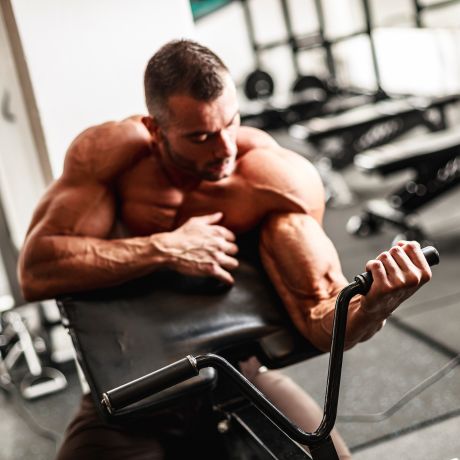
Other Biceps Exercises
The five barbell bicep exercises above ought to be the staple of all biceps workouts, but it surely’s necessary to make use of isolation exercises to maximise biceps muscle growth.
Some great bicep isolation exercises include:
Isolation bicep exercises ought to be performed at the tip of the workout as a approach to goal a particular head of the biceps, upper arms, or forearms, especially for those who are doing a whole arm workout (relatively than simply biceps). These kinds of bicep exercises ought to be done at the next repetition range, ideally within the ten to fifteen range, using a moderate weight that will be accomplished in a controlled manner with a full range of motion.
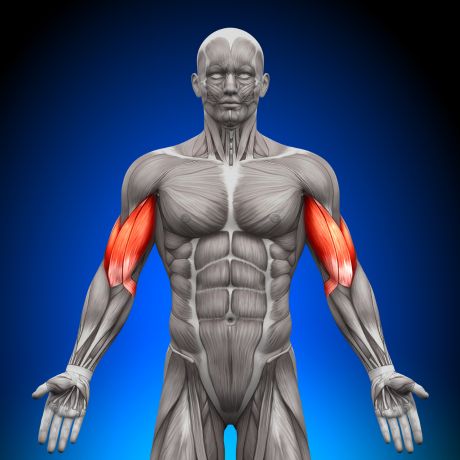
Anatomy of the Biceps
The biceps brachii is one in all the 2 major muscles of the upper arm together with the triceps. The origin of the word is derived from the Latin words “bi” and “ceps,” which suggests “two heads.” It’s because there are two biceps heads, the long head and the short head.
- Long head – The long head of the biceps starts from the supraglenoid tubercle of the scapula (shoulder blade), which is just above the shoulder joint. The long head is the highest portion of the biceps that somebody might touch as you flex or the height of the muscle.
- Short head – The short head of the biceps starts from the coracoid strategy of the shoulder blade, which is on the front of the scapula near the shoulder joint. The short head is the portion you see below the long head, which runs in towards the armpit.
The 2 heads mix to form the biceps brachii, connecting the upper arm to the radius bone on the forearm.
Functions:
- Elbow flexion: The major purpose of the biceps is literally flexing…of the elbow joint. The bicep’s primary function is flexion of the elbow joint to permit the hands to maneuver closer to the shoulders.
- Forearm rotation: The biceps also assist within the rotation of the palm upward or forward, which is known as forearm supination.
- Stabilizer: The last primary purpose of the biceps is to stabilize the shoulder joint. This mainly applies to the long head of the biceps since it starts on the scapula. Stabilization is particularly necessary for overhead movements or lifting heavy items.
Accessory Muscles
Every exercise that targets the biceps also involves the brachialis and brachioradialis because these muscles work in unison with the biceps during elbow flexion. Although they don’t seem to be technically a part of the identical muscle group, they’re closely related.
- Brachialis: The brachialis, a muscle under the biceps, is the strongest elbow flexor. It starts at the underside of the humerus (upper arm bone) and connects to the ulna bone of the forearm.
- Brachioradialis: The brachioradialis is the long muscle on the lateral (outer) side of the forearms that helps flex the elbow, especially from a semi-pronated or neutral grip. You’ll be able to see this muscle flexed during any curling exercise.
Forearm muscles are divided into two categories:
- Anterior forearm flexors
- Posterior forearm extensors
Forearm flexors are on the palm side (anterior) of the arm and help to flex the wrist and fingers, in addition to forearm pronation. The forearm extensors are on the back of the forearm (posterior) and help to increase the wrist and fingers, in addition to forearm supination. All of those forearm muscles play a key role in maintaining grip strength and stabilizing the wrists throughout the barbell curl and other curl variations.
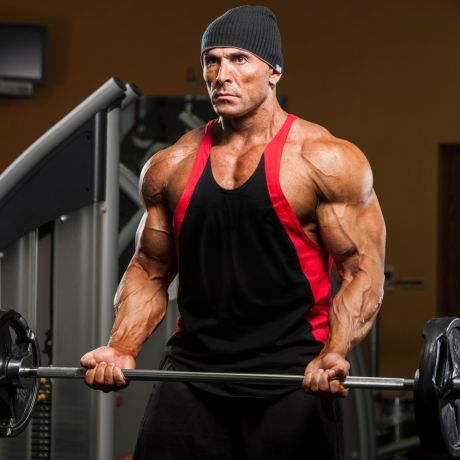
Programming Suggestions
- Barbell exercises first: Research has shown that training large muscle groups with compound movements is simpler first, then progressing to smaller muscles.¹ An example is training the forearms last after your biceps workout. This can also be why you must do barbell exercises first, then progress to machines or isolation movements, just like the dumbbell curl. You wish your muscles to be fresh for a very powerful exercises.
- Form > Weight: While true for any muscle group, it’s especially necessary when training biceps to concentrate on form relatively than heavy weights. You’ll make significantly higher progress for those who use lighter weights with a full range of motion in a controlled manner relatively than using heavier weights with bad form. The biceps are small muscles; they do not need extreme resistance to grow.
- Hand position: Hand positioning is crucial when training any muscle group, especially for a bicep exercise. Studies have shown significantly more muscular activity of the brachioradialis during elbow flexion with an overhand (pronated) grip in comparison with a neutral or underhand (supinated) grip.² Any bicep curl with an overhand (pronated) grip primarily works the short head, while underhand targets the long head of the biceps. Exercises just like the hammer curl that utilize a neutral grip (palms facing one another) primarily hit the brachialis.

Outro
Biceps training is crucial for constructing arm muscles and overall upper-body development. Depending in your routine split, you likely do the bicep workout as a part of an arm workout or upper body day. No matter whenever you train, your bicep workout ought to be centered across the barbell curl and other barbell workouts. A few of the handiest biceps exercises include the barbell curl, preacher curl, drag curl, spider curl, and reverse barbell curl.
Should you want larger biceps, add these exercises to your biceps workout and perform the compound barbell lifts first, then isolation exercises at the tip to sculpt lacking areas of the upper arms. Give attention to having perfect form with a full range of motion where you’ll be able to squeeze the contraction as much as possible relatively than ego lifting with bad form. Lastly, listen to your hand positions and alter them occasionally to construct a whole bicep muscle.
References






